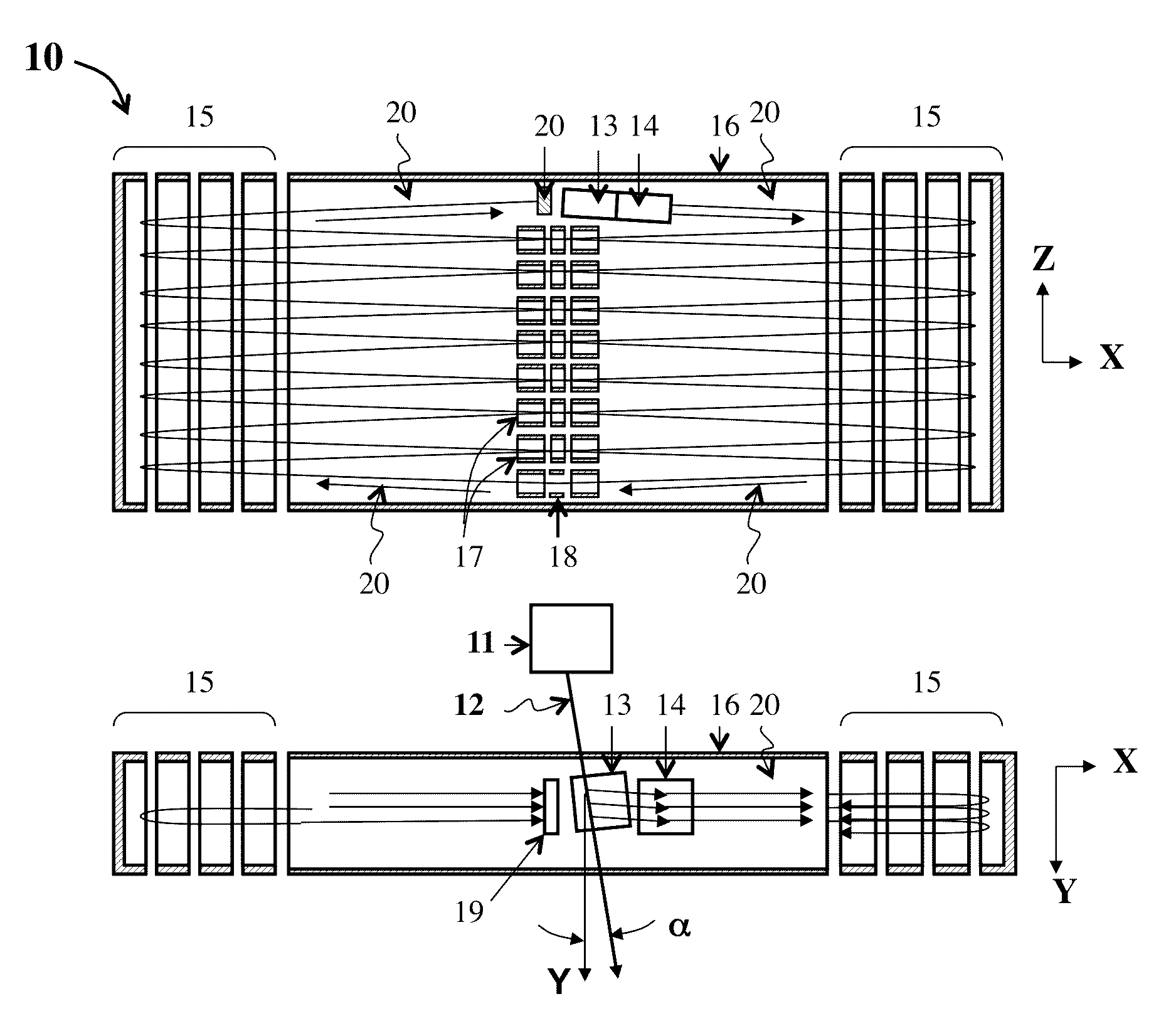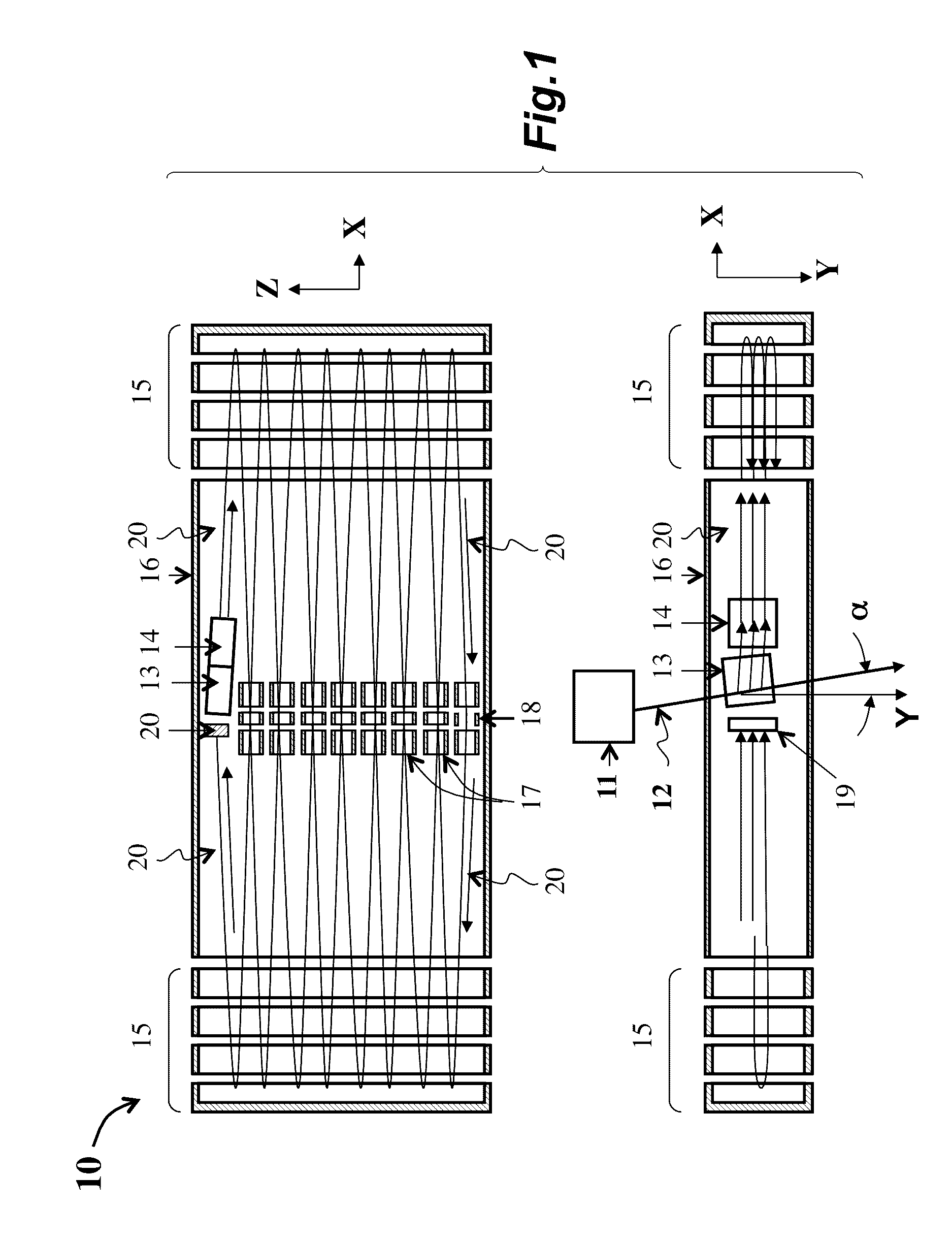Multi-Reflecting Time-of-Flight Mass Spectrometer with Axial Pulsed Converter
- Summary
- Abstract
- Description
- Claims
- Application Information
AI Technical Summary
Benefits of technology
Problems solved by technology
Method used
Image
Examples
embodiment 10
[0056]Referring to FIG. 1, an embodiment 10 of a MR-TOF MS utilizing an orthogonal accelerator (OA) 13 of WO2007044696, which is incorporated herein by reference, comprises a continuous ion source 11, the OA 13 with a steering lens 14, a pair of parallel and gridless ion mirrors 15 separated by a negatively floated drift space 16, a periodic lens 17 with a steering deflector 18, and a detector 19. In operation, a well-directed continuous ion beam 12 is introduced into OA substantially along the Y-axis. Periodic pulses (not shown), which are applied to plates of the OA 13, accelerate ion ribbon packets into the drift space of the MR-TOF MS and along a jigsaw trajectory 20. At the OA 13, the trajectory of the ion beam is offset from the Y-axis at a small angle α, which enables compensation for time-of-flight aberrations at ion beam steering, while using a finite energy level for the ion beam 12 between 20 eV and 100 eV.
[0057]Practical implementations of the scheme illustrated in FIG. ...
embodiment 41
[0107]Referring to FIG. 4, a preferred embodiment 41 of time-of-flight mass spectrometer performing the axial bunching method 31 of the disclosure includes the following sequentially and axially aligned components: a continuous source 42, a continuous acceleration stage 43 (i.e. an accelerator), a spatially focusing lens 44, a suppresser 45, a buncher formed with parallel electrodes 46 and 48, an energy filter 49, and a TOF analyzer 50, which may be either Re-TOF or MR-TOF. Pulse generators, depicted by gate icons, are connected to electrodes 45 and 46.
[0108]In operation, a suitable continuous ion source 42 generates a continuous ion beam (shown in FIG. 4 by a white arrow) with less than 10 eV energy spread ΔK, and more preferably ΔK42 generates ions in a wide mass range as presented by black circles of different size. The accelerator 43 continuously accelerates the ion beam to a mean energy KC, which at least ten times larger than the energy spread ΔK. The absolute velocity spread ...
embodiment 71
[0117]Referring to FIG. 7A, an embodiment 71 of the pulsed converter optionally includes a closed electron impact (EI) ion source 42, an electrostatic acceleration stage 43, an axial symmetric lens 44, a gridless buncher 47 depicted between entrance section 46 and exit section 48, and an energy filter 79. The gridless buncher 47 may optionally be embodied as the buncher illustrated in FIG. 6A. The energy filter 79 comprises a planar lens 72, a first electrostatic sector 73, a second electrostatic sector 74, a third electrostatic sector 75, a set of surrounding slits 76, and an energy filtering slit 77.
[0118]The closed EI ion source 42, which is grounded, generates an ion beam with an energy spread of approximately 1 eV. After accelerating the ion beam to 1500 eV at the electrostatic acceleration stage 43 (floated to −1500V), the ion beam emittance is estimated as 2 mm*deg, based on experimental data. The axial symmetric lens 44 provides spatial focusing at a middle of the buncher 47...
PUM
 Login to View More
Login to View More Abstract
Description
Claims
Application Information
 Login to View More
Login to View More - R&D
- Intellectual Property
- Life Sciences
- Materials
- Tech Scout
- Unparalleled Data Quality
- Higher Quality Content
- 60% Fewer Hallucinations
Browse by: Latest US Patents, China's latest patents, Technical Efficacy Thesaurus, Application Domain, Technology Topic, Popular Technical Reports.
© 2025 PatSnap. All rights reserved.Legal|Privacy policy|Modern Slavery Act Transparency Statement|Sitemap|About US| Contact US: help@patsnap.com



